Sinh viên chuyên ngành tiếng Anh tham gia giờ học kỹ năng nói tiếng Anh - Hiện trạng và giải pháp
Sự tham gia của sinh viên trong giờ học là vô cùng quan trọng trong quá trình dạy và học. Khi phát biểu
ý kiến trong lớp, sinh viên học được cách trình bày ý tưởng để người khác hiểu được. Khi đặt câu hỏi,
sinh viên học được cách thu nhận thông tin để tăng vốn hiểu biết về một chủ đề. Thông qua câu hỏi của
sinh viên, giáo viên cũng biết được khó khăn sinh viên gặp phải và từ đó điều chỉnh cách dạy của mình
cho hiệu quả hơn. Tuy nhiên, nhiều sinh viên chuyên ngành tiếng Anh tại Trường Đại học Hải Phòng
chưa tích cực tham gia vào hoạt động học tập trong các giờ học kỹ năng nói tiếng Anh. Bài viết trình
bày nguyên nhân của tình trạng trên và đề ra một số giải pháp để khuyến khích sinh viên tham gia hoạt
động học tập trên lớp hiệu quả.
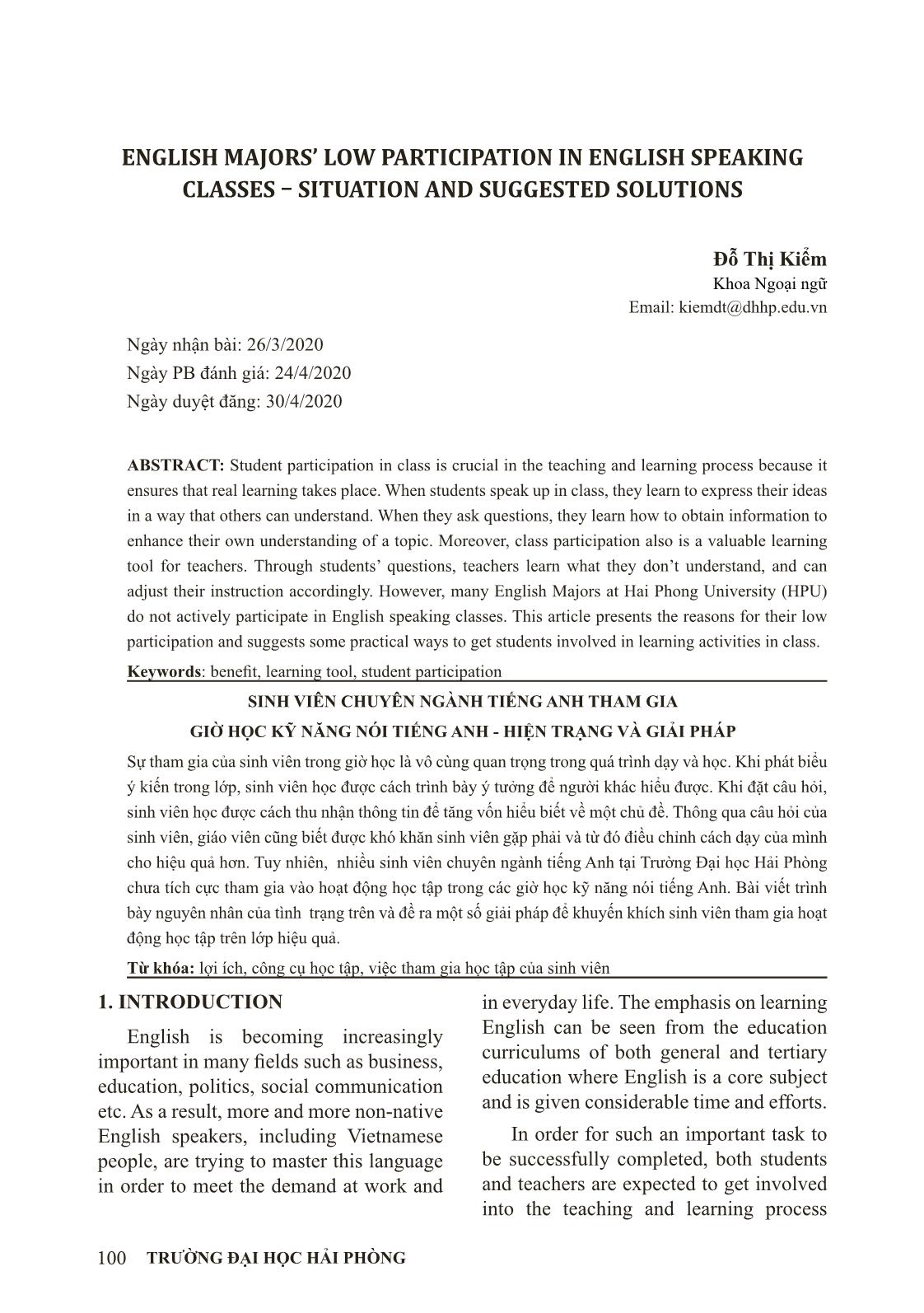
Trang 1
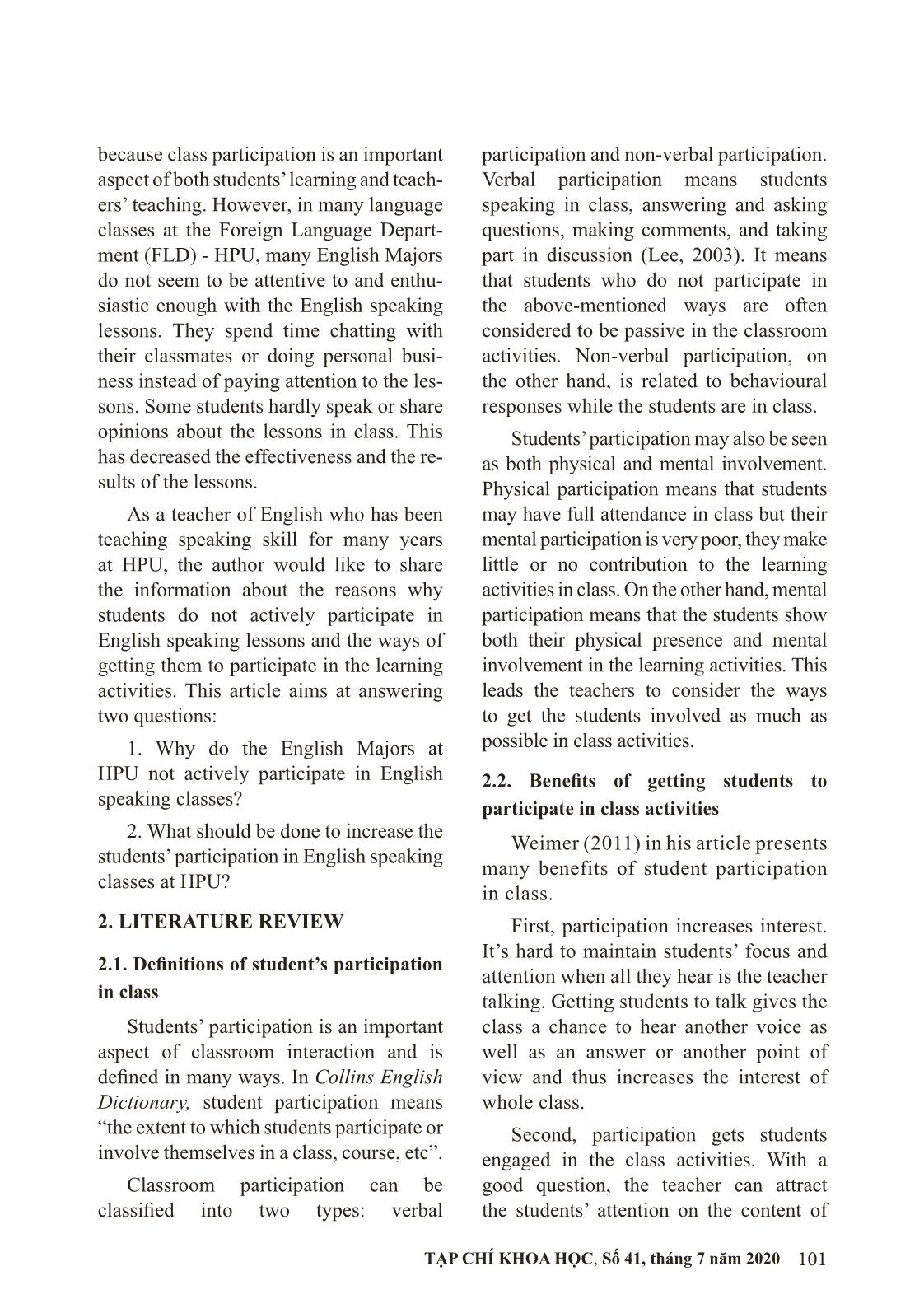
Trang 2
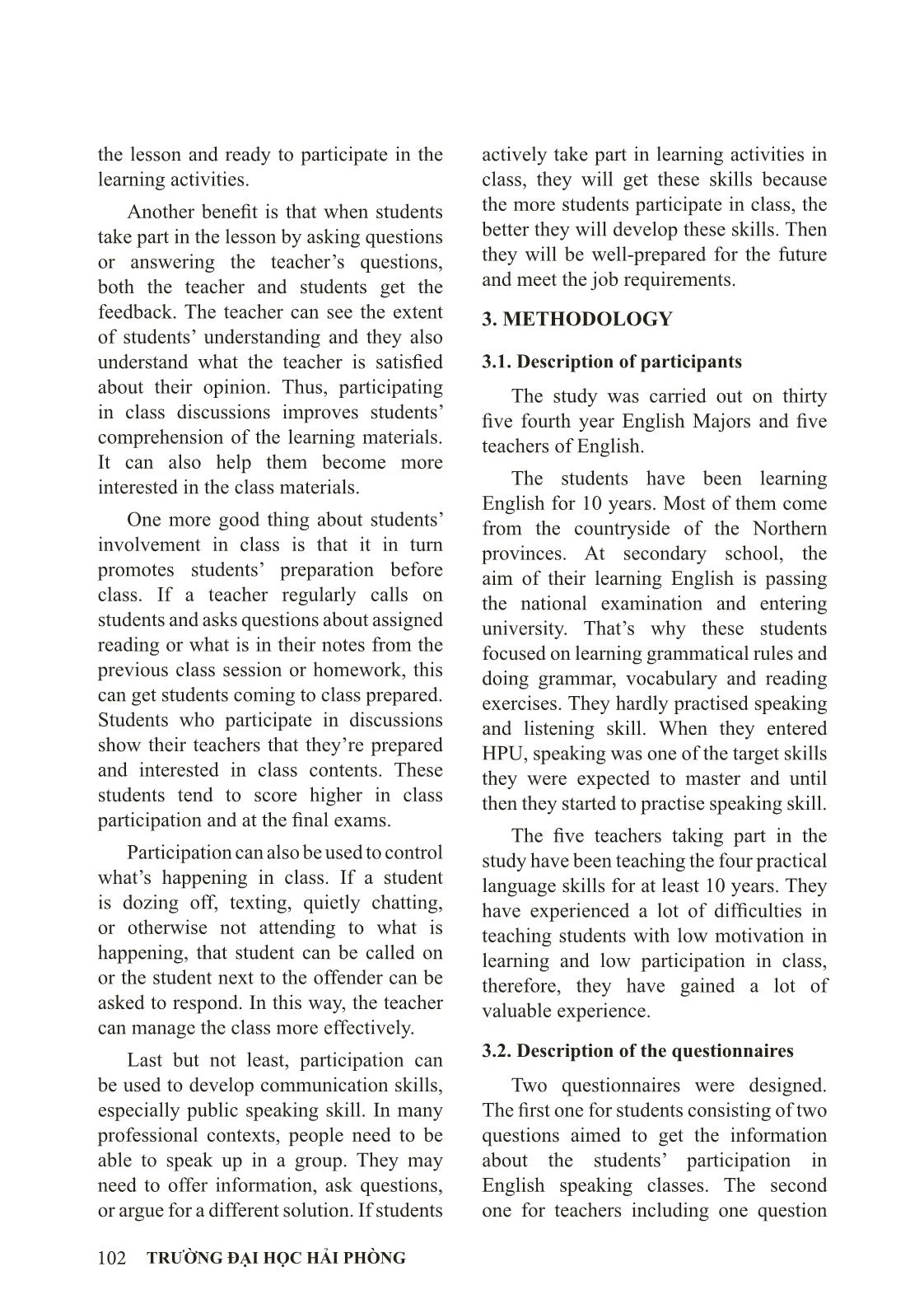
Trang 3
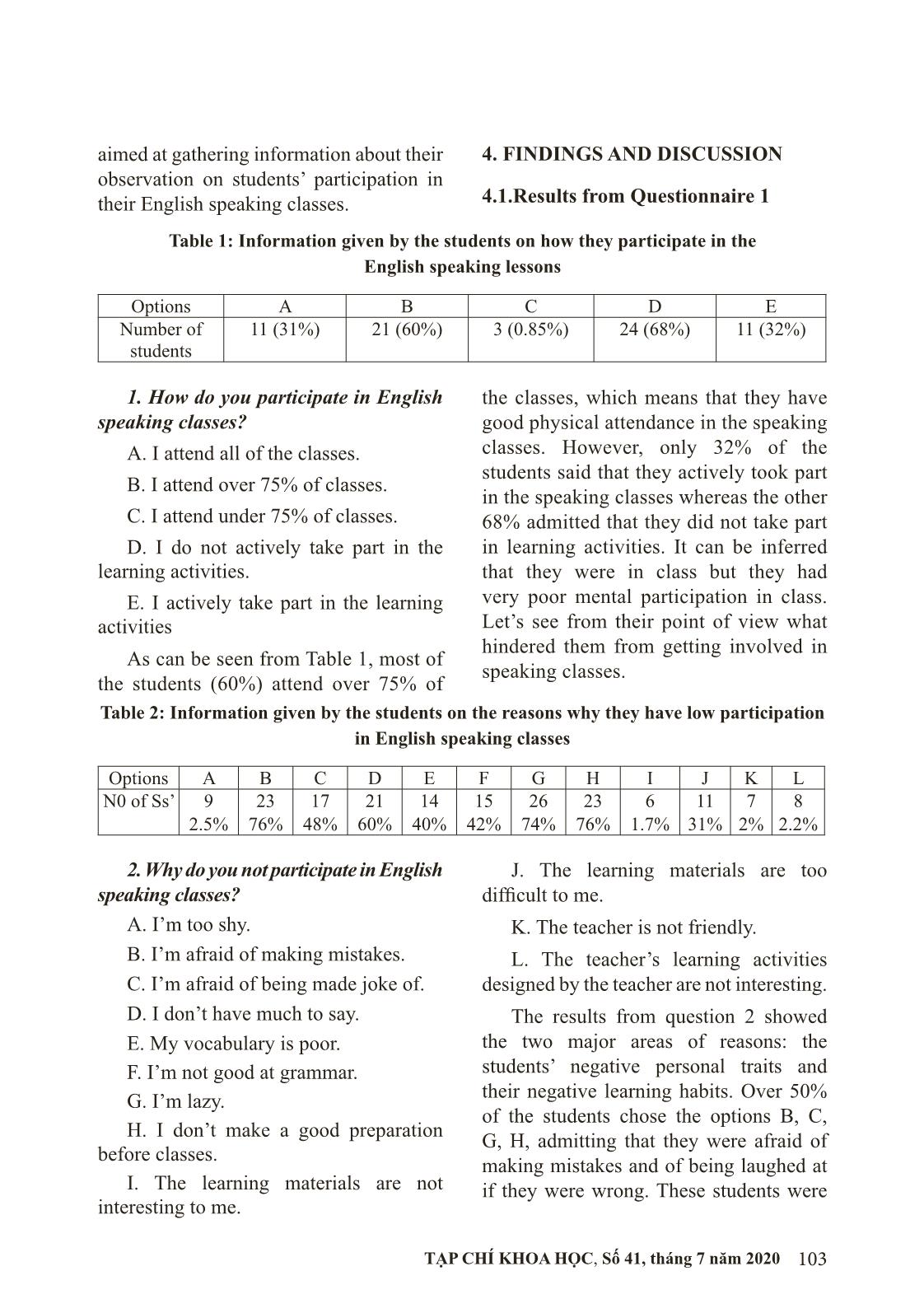
Trang 4
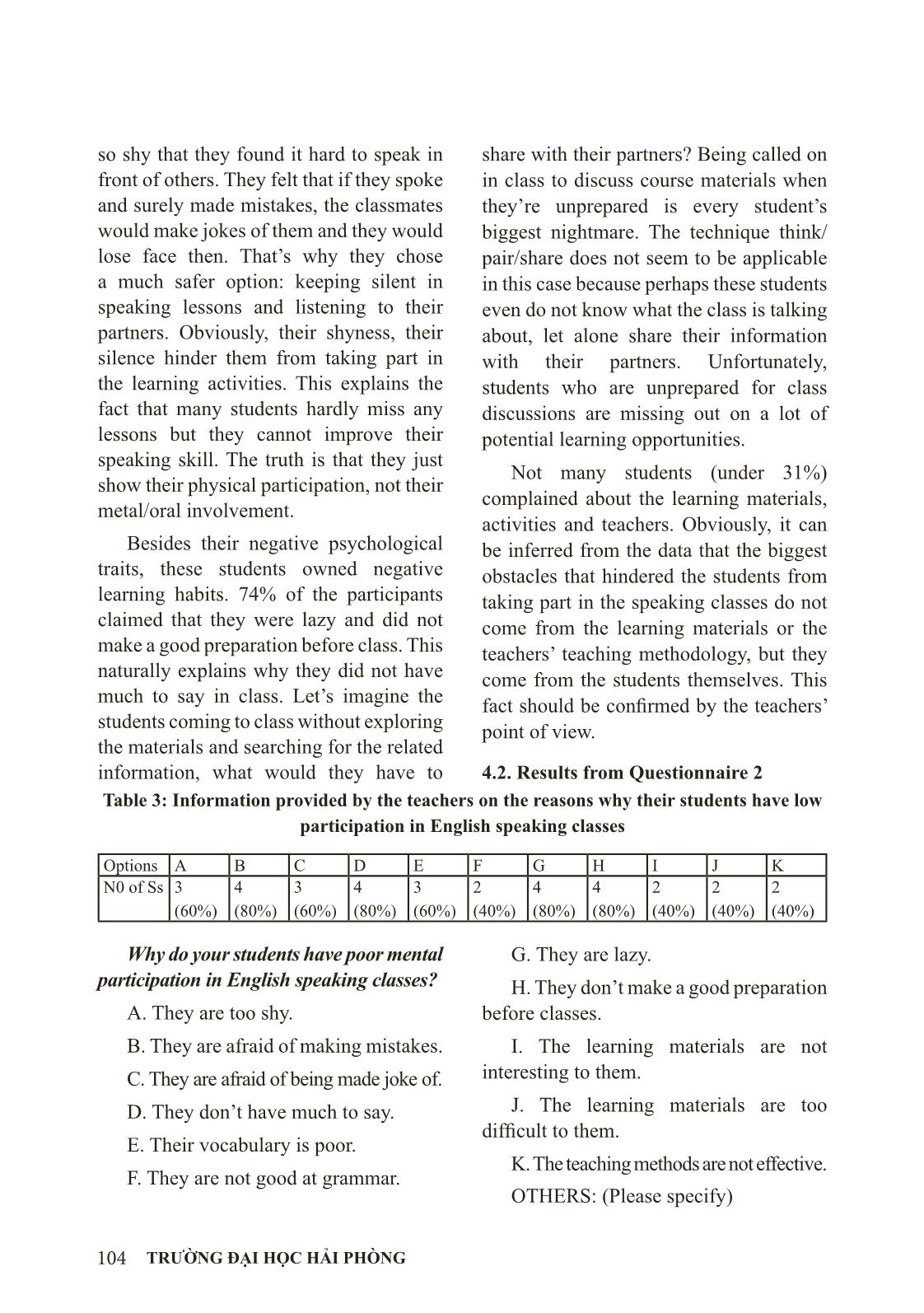
Trang 5
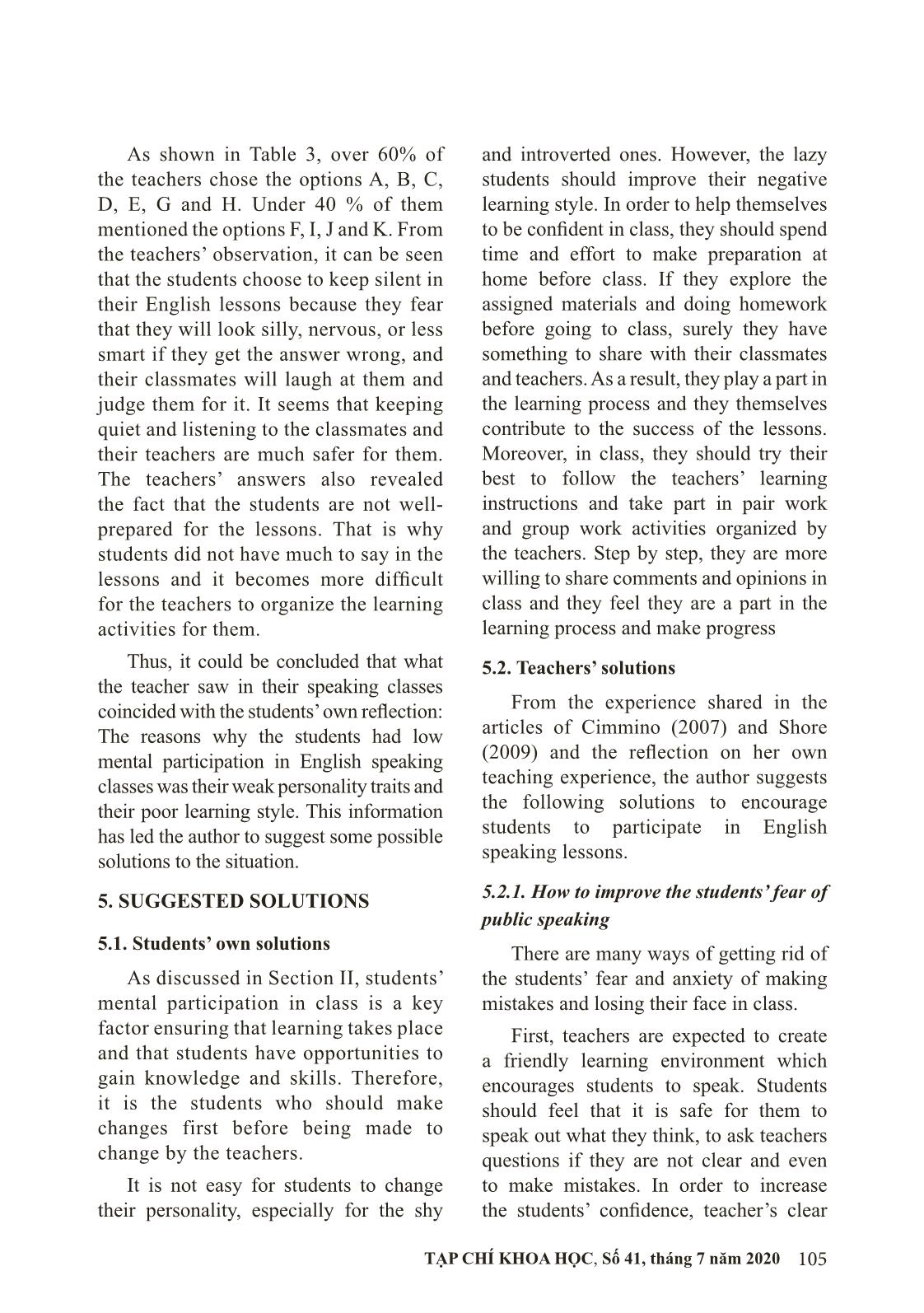
Trang 6
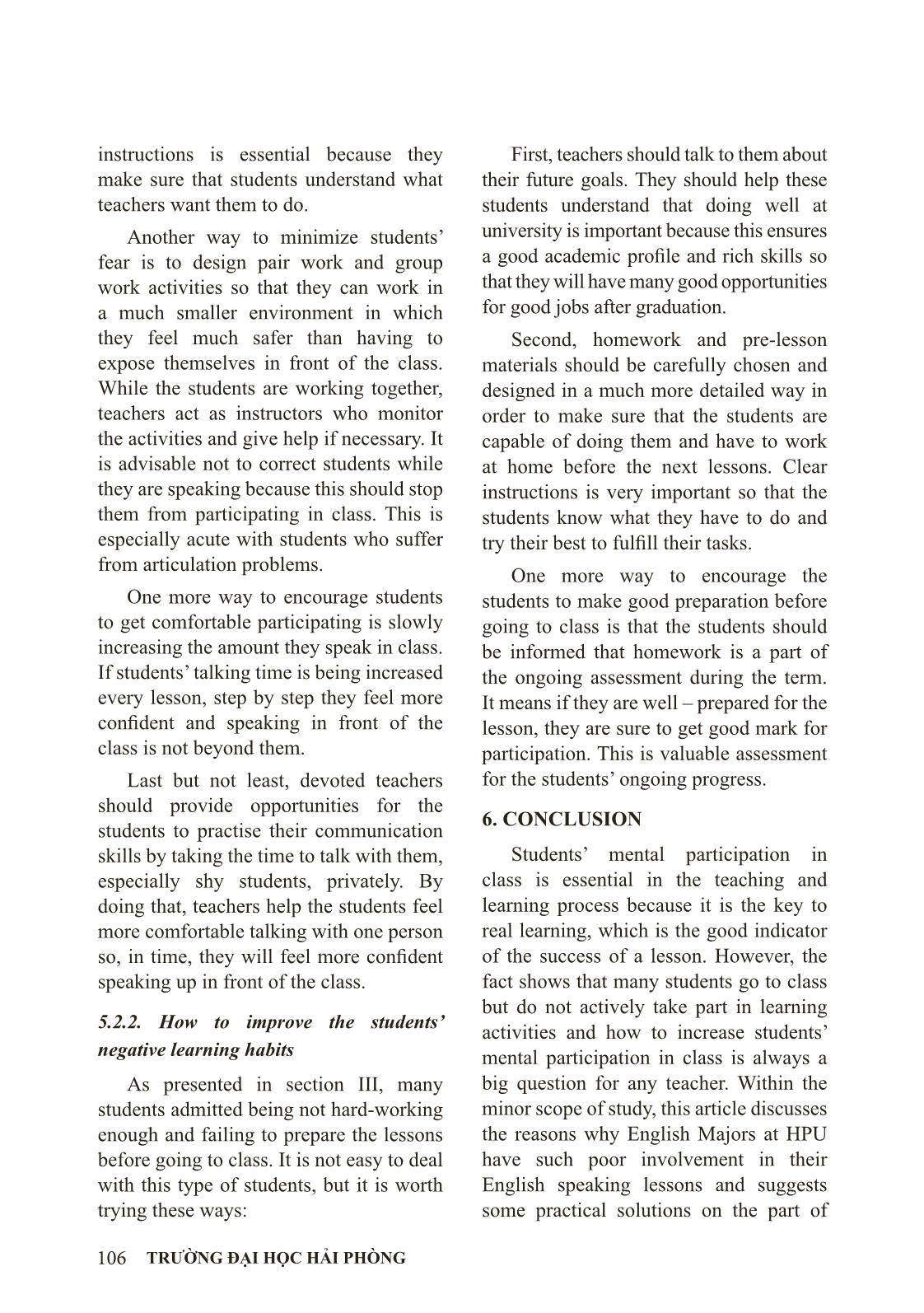
Trang 7
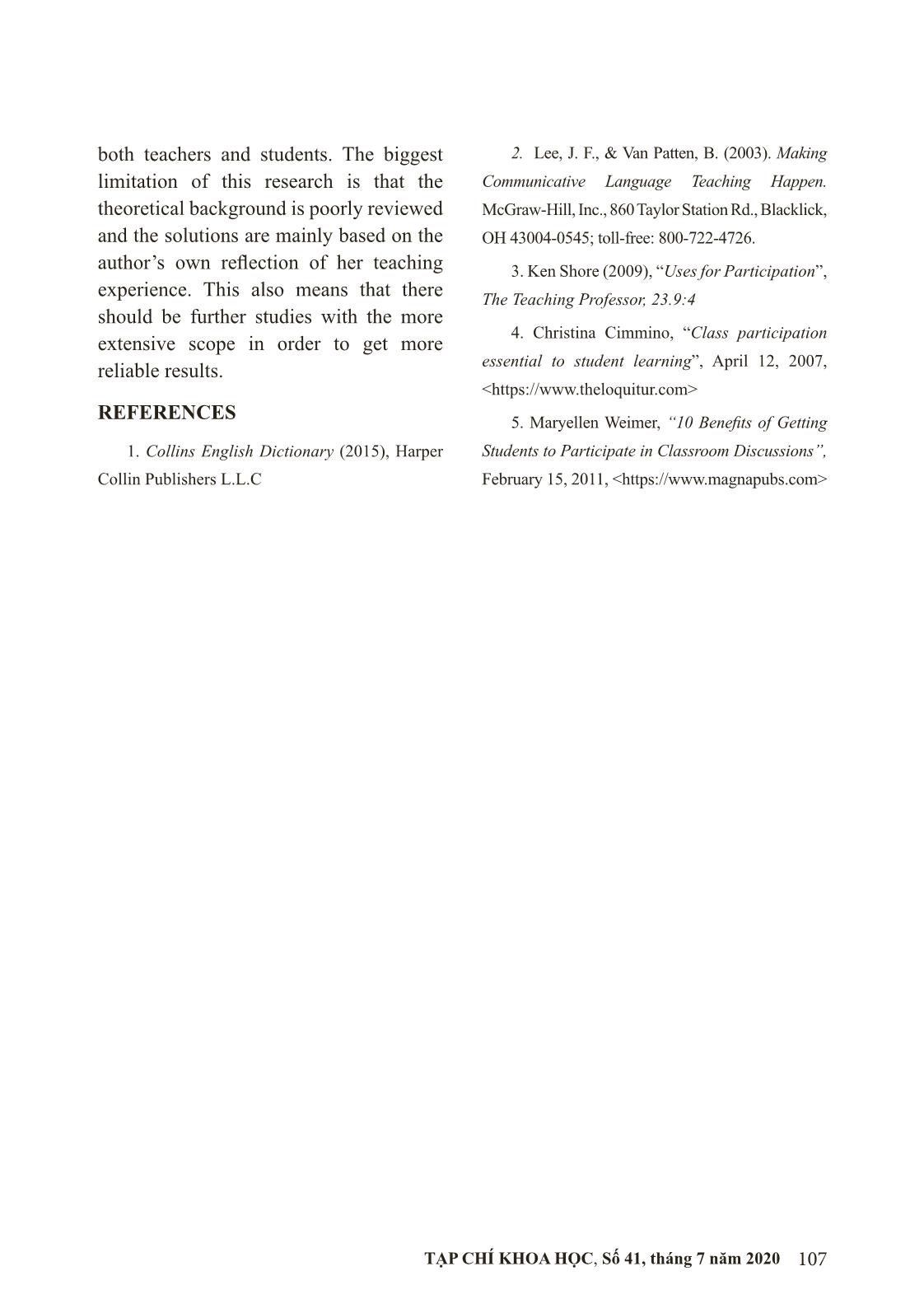
Trang 8
Tóm tắt nội dung tài liệu: Sinh viên chuyên ngành tiếng Anh tham gia giờ học kỹ năng nói tiếng Anh - Hiện trạng và giải pháp
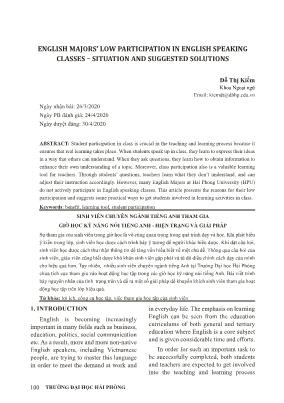
t to the offender can be asked to respond. In this way, the teacher can manage the class more effectively. Last but not least, participation can be used to develop communication skills, especially public speaking skill. In many professional contexts, people need to be able to speak up in a group. They may need to offer information, ask questions, or argue for a different solution. If students actively take part in learning activities in class, they will get these skills because the more students participate in class, the better they will develop these skills. Then they will be well-prepared for the future and meet the job requirements. 3. METHODOLOGY 3.1. Description of participants The study was carried out on thirty five fourth year English Majors and five teachers of English. The students have been learning English for 10 years. Most of them come from the countryside of the Northern provinces. At secondary school, the aim of their learning English is passing the national examination and entering university. That’s why these students focused on learning grammatical rules and doing grammar, vocabulary and reading exercises. They hardly practised speaking and listening skill. When they entered HPU, speaking was one of the target skills they were expected to master and until then they started to practise speaking skill. The five teachers taking part in the study have been teaching the four practical language skills for at least 10 years. They have experienced a lot of difficulties in teaching students with low motivation in learning and low participation in class, therefore, they have gained a lot of valuable experience. 3.2. Description of the questionnaires Two questionnaires were designed. The first one for students consisting of two questions aimed to get the information about the students’ participation in English speaking classes. The second one for teachers including one question 103TẠP CHÍ KHOA HỌC, Số 41, tháng 7 năm 2020 aimed at gathering information about their observation on students’ participation in their English speaking classes. 4. FINDINGS AND DISCUSSION 4.1.Results from Questionnaire 1 Table 1: Information given by the students on how they participate in the English speaking lessons Options A B C D E Number of students 11 (31%) 21 (60%) 3 (0.85%) 24 (68%) 11 (32%) 1. How do you participate in English speaking classes? A. I attend all of the classes. B. I attend over 75% of classes. C. I attend under 75% of classes. D. I do not actively take part in the learning activities. E. I actively take part in the learning activities As can be seen from Table 1, most of the students (60%) attend over 75% of the classes, which means that they have good physical attendance in the speaking classes. However, only 32% of the students said that they actively took part in the speaking classes whereas the other 68% admitted that they did not take part in learning activities. It can be inferred that they were in class but they had very poor mental participation in class. Let’s see from their point of view what hindered them from getting involved in speaking classes. Table 2: Information given by the students on the reasons why they have low participation in English speaking classes Options A B C D E F G H I J K L N0 of Ss’ 9 2.5% 23 76% 17 48% 21 60% 14 40% 15 42% 26 74% 23 76% 6 1.7% 11 31% 7 2% 8 2.2% 2. Why do you not participate in English speaking classes? A. I’m too shy. B. I’m afraid of making mistakes. C. I’m afraid of being made joke of. D. I don’t have much to say. E. My vocabulary is poor. F. I’m not good at grammar. G. I’m lazy. H. I don’t make a good preparation before classes. I. The learning materials are not interesting to me. J. The learning materials are too difficult to me. K. The teacher is not friendly. L. The teacher’s learning activities designed by the teacher are not interesting. The results from question 2 showed the two major areas of reasons: the students’ negative personal traits and their negative learning habits. Over 50% of the students chose the options B, C, G, H, admitting that they were afraid of making mistakes and of being laughed at if they were wrong. These students were 104 TRƯỜNG ĐẠI HỌC HẢI PHÒNG so shy that they found it hard to speak in front of others. They felt that if they spoke and surely made mistakes, the classmates would make jokes of them and they would lose face then. That’s why they chose a much safer option: keeping silent in speaking lessons and listening to their partners. Obviously, their shyness, their silence hinder them from taking part in the learning activities. This explains the fact that many students hardly miss any lessons but they cannot improve their speaking skill. The truth is that they just show their physical participation, not their metal/oral involvement. Besides their negative psychological traits, these students owned negative learning habits. 74% of the participants claimed that they were lazy and did not make a good preparation before class. This naturally explains why they did not have much to say in class. Let’s imagine the students coming to class without exploring the materials and searching for the related information, what would they have to share with their partners? Being called on in class to discuss course materials when they’re unprepared is every student’s biggest nightmare. The technique think/ pair/share does not seem to be applicable in this case because perhaps these students even do not know what the class is talking about, let alone share their information with their partners. Unfortunately, students who are unprepared for class discussions are missing out on a lot of potential learning opportunities. Not many students (under 31%) complained about the learning materials, activities and teachers. Obviously, it can be inferred from the data that the biggest obstacles that hindered the students from taking part in the speaking classes do not come from the learning materials or the teachers’ teaching methodology, but they come from the students themselves. This fact should be confirmed by the teachers’ point of view. 4.2. Results from Questionnaire 2 Table 3: Information provided by the teachers on the reasons why their students have low participation in English speaking classes Options A B C D E F G H I J K N0 of Ss 3 (60%) 4 (80%) 3 (60%) 4 (80%) 3 (60%) 2 (40%) 4 (80%) 4 (80%) 2 (40%) 2 (40%) 2 (40%) Why do your students have poor mental participation in English speaking classes? A. They are too shy. B. They are afraid of making mistakes. C. They are afraid of being made joke of. D. They don’t have much to say. E. Their vocabulary is poor. F. They are not good at grammar. G. They are lazy. H. They don’t make a good preparation before classes. I. The learning materials are not interesting to them. J. The learning materials are too difficult to them. K. The teaching methods are not effective. OTHERS: (Please specify) 105TẠP CHÍ KHOA HỌC, Số 41, tháng 7 năm 2020 As shown in Table 3, over 60% of the teachers chose the options A, B, C, D, E, G and H. Under 40 % of them mentioned the options F, I, J and K. From the teachers’ observation, it can be seen that the students choose to keep silent in their English lessons because they fear that they will look silly, nervous, or less smart if they get the answer wrong, and their classmates will laugh at them and judge them for it. It seems that keeping quiet and listening to the classmates and their teachers are much safer for them. The teachers’ answers also revealed the fact that the students are not well- prepared for the lessons. That is why students did not have much to say in the lessons and it becomes more difficult for the teachers to organize the learning activities for them. Thus, it could be concluded that what the teacher saw in their speaking classes coincided with the students’ own reflection: The reasons why the students had low mental participation in English speaking classes was their weak personality traits and their poor learning style. This information has led the author to suggest some possible solutions to the situation. 5. SUGGESTED SOLUTIONS 5.1. Students’ own solutions As discussed in Section II, students’ mental participation in class is a key factor ensuring that learning takes place and that students have opportunities to gain knowledge and skills. Therefore, it is the students who should make changes first before being made to change by the teachers. It is not easy for students to change their personality, especially for the shy and introverted ones. However, the lazy students should improve their negative learning style. In order to help themselves to be confident in class, they should spend time and effort to make preparation at home before class. If they explore the assigned materials and doing homework before going to class, surely they have something to share with their classmates and teachers. As a result, they play a part in the learning process and they themselves contribute to the success of the lessons. Moreover, in class, they should try their best to follow the teachers’ learning instructions and take part in pair work and group work activities organized by the teachers. Step by step, they are more willing to share comments and opinions in class and they feel they are a part in the learning process and make progress 5.2. Teachers’ solutions From the experience shared in the articles of Cimmino (2007) and Shore (2009) and the reflection on her own teaching experience, the author suggests the following solutions to encourage students to participate in English speaking lessons. 5.2.1. How to improve the students’ fear of public speaking There are many ways of getting rid of the students’ fear and anxiety of making mistakes and losing their face in class. First, teachers are expected to create a friendly learning environment which encourages students to speak. Students should feel that it is safe for them to speak out what they think, to ask teachers questions if they are not clear and even to make mistakes. In order to increase the students’ confidence, teacher’s clear 106 TRƯỜNG ĐẠI HỌC HẢI PHÒNG instructions is essential because they make sure that students understand what teachers want them to do. Another way to minimize students’ fear is to design pair work and group work activities so that they can work in a much smaller environment in which they feel much safer than having to expose themselves in front of the class. While the students are working together, teachers act as instructors who monitor the activities and give help if necessary. It is advisable not to correct students while they are speaking because this should stop them from participating in class. This is especially acute with students who suffer from articulation problems. One more way to encourage students to get comfortable participating is slowly increasing the amount they speak in class. If students’ talking time is being increased every lesson, step by step they feel more confident and speaking in front of the class is not beyond them. Last but not least, devoted teachers should provide opportunities for the students to practise their communication skills by taking the time to talk with them, especially shy students, privately. By doing that, teachers help the students feel more comfortable talking with one person so, in time, they will feel more confident speaking up in front of the class. 5.2.2. How to improve the students’ negative learning habits As presented in section III, many students admitted being not hard-working enough and failing to prepare the lessons before going to class. It is not easy to deal with this type of students, but it is worth trying these ways: First, teachers should talk to them about their future goals. They should help these students understand that doing well at university is important because this ensures a good academic profile and rich skills so that they will have many good opportunities for good jobs after graduation. Second, homework and pre-lesson materials should be carefully chosen and designed in a much more detailed way in order to make sure that the students are capable of doing them and have to work at home before the next lessons. Clear instructions is very important so that the students know what they have to do and try their best to fulfill their tasks. One more way to encourage the students to make good preparation before going to class is that the students should be informed that homework is a part of the ongoing assessment during the term. It means if they are well – prepared for the lesson, they are sure to get good mark for participation. This is valuable assessment for the students’ ongoing progress. 6. CONCLUSION Students’ mental participation in class is essential in the teaching and learning process because it is the key to real learning, which is the good indicator of the success of a lesson. However, the fact shows that many students go to class but do not actively take part in learning activities and how to increase students’ mental participation in class is always a big question for any teacher. Within the minor scope of study, this article discusses the reasons why English Majors at HPU have such poor involvement in their English speaking lessons and suggests some practical solutions on the part of 107TẠP CHÍ KHOA HỌC, Số 41, tháng 7 năm 2020 both teachers and students. The biggest limitation of this research is that the theoretical background is poorly reviewed and the solutions are mainly based on the author’s own reflection of her teaching experience. This also means that there should be further studies with the more extensive scope in order to get more reliable results. REFERENCES 1. Collins English Dictionary (2015), Harper Collin Publishers L.L.C 2. Lee, J. F., & Van Patten, B. (2003). Making Communicative Language Teaching Happen. McGraw-Hill, Inc., 860 Taylor Station Rd., Blacklick, OH 43004-0545; toll-free: 800-722-4726. 3. Ken Shore (2009), “Uses for Participation”, The Teaching Professor, 23.9:4 4. Christina Cimmino, “Class participation essential to student learning”, April 12, 2007, 5. Maryellen Weimer, “10 Benefits of Getting Students to Participate in Classroom Discussions”, February 15, 2011,
File đính kèm:
 sinh_vien_chuyen_nganh_tieng_anh_tham_gia_gio_hoc_ky_nang_no.pdf
sinh_vien_chuyen_nganh_tieng_anh_tham_gia_gio_hoc_ky_nang_no.pdf

